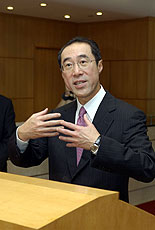
|
Looking up: Financial Secretary Henry Tang says he is pleased to see a moderate improvement in the employment situation. |
As the labour market continued to improve, the unemployment rate for the quarter ending August fell to a 30-month record low of 6.8%, down 0.1% on the May-to-July period.
Total employment rose by 6,800 soaring to a record high of 3.294 million, with the underemployment rate falling from 3.5% to 3.3%. The total labour force rose by 7,600 to 3.535 million.
Unemployment falls were seen in the retail trade, restaurant, business services, and welfare and community services sectors, while rises were seen in the insurance, and amusement and recreational services sectors.
The underemployment fall was concentrated in the hotels, transport, communications, amusement and recreational services, and education services sectors, more than offsetting the rise in the decoration and maintenance sector.
However, the number of unemployed people rose by 800 to 249,000, while the number of underemployed fell by about 4,100 to 118,000.
Employment situation remains challenging
Financial Secretary Henry Tang said he was pleased to see the improvements, but said the situation remains challenging as 6.8% is still a very high unemployment rate, with 249,000 people jobless.
He said the Government is concerned about the challenges of the economic restructuring and will continue to work closely with the labour sector and facilitate the business environment to create more jobs.
Mr Tang called on employers to consider staff pay rises if their business allows, to retain capable employees.
After discounting the seasonal influence of increased entry of fresh graduates and school leavers into the labour market, there was a slight fall in the seasonally adjusted unemployment rate. The near-term outlook will hinge on continued growth in the economy, giving rise to additional jobs for absorbing the new entrants into the workforce.
Record high job placements
The overall labour market sentiment remained generally buoyant. For August, the Labour Department received an all-time high of 29,505 job vacancies from the private sector, up 16.2% on July, or 11.6% over the last peak of 26,427 in March.
The department received an average of 1,200 private sector vacancies each working day in August, up 200 from the daily norm of about 1,000 since February. The major increases were in the catering, business services and retail industries. It also successfully placed 7,683 people into jobs, also a record high.
However, with the entry of a batch of fresh graduates and school leavers into the labour market during the summer months, there is still pressure on employment.
The department has received nearly 23,000 applications for the Youth Pre-employment Training Programme and the Youth Work Experience and Training Scheme. Although the joint enrolment exercise has ended, youngsters aged between 15 and 24 are welcome to join the programmes any time.
44,000 new jobs annually in the next five years
Whilst still on the high side, the unemployment rate for the construction sector has fallen from the peak of 20% in August-October last year to 16.3% in May-July this year, while the number of unemployed in the industry fell more than 20% or 13,200 to 51,400.
The Government has earmarked an average of $29 billion a year for capital works projects for the next five years, creating some 44,000 jobs annually. Current ongoing capital projects include Route 8 and Stonecutter Bridge, improvement to the Tung Chung Road, and the new infectious disease centre attached to Princess Margaret Hospital, creating some 3,150 jobs.
The construction of Hong Kong Disneyland has created over 5,700 jobs, with another 4,000 expected during the construction peak in 2004-05. These, together with 27 hotels to be completed by 2006, will further improve the employment situation.
|